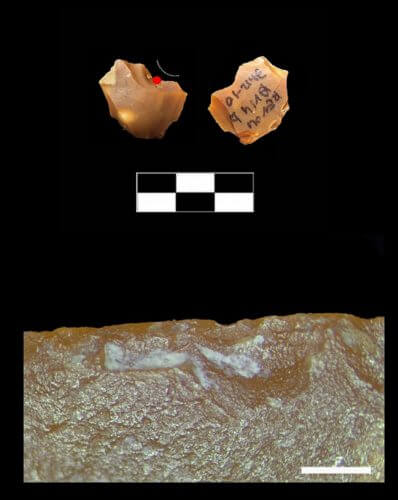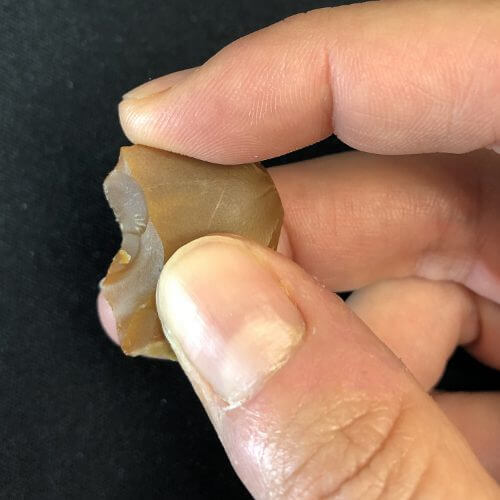In a three-year study, led by archaeologists from Tel Aviv University, which included microscopic analyzes of hundreds of tiny flint spatters from the site of Rabadi, the researchers uncovered 107 tiny spatters with signs of use from animal slaughter * The results of the new study were published on September 10.9 in the journal Scientific Reports from Nature

An international team of researchers, led by Dr. Flavia Venditti and Prof. Ran Barkai from the Department of Archeology and Ancient Near Eastern Cultures at Tel Aviv University, conducted innovative analyzes of tiny flint fragments 300 to 500 thousand years old that were found at the Ravadi prehistoric site in the center of the country.
From the microscopic analysis and the analysis of the organic remains identified on the tiny flint tools, the researchers conclude that the flint splashes were not industrial waste, left over from the production of larger tools, but rather a deliberate and intelligent result of the recycling of existing flint tools - recycling that was used by the site's residents for the surgical dissection of elephants and other animals.
"These are innovative analyzes of old flint items, from the Lower Paleolithic period, which include microscopic observations for signs of use - use-wear analysis - and organic remains - residue analysis," explains Prof. Barkai. "Basically, we were looking for signs of wear, breakage, scratches and even organic remains left in the folds of the flint splashes, all with the aim of understanding what they were used for."

The tiny splashes also had an important use
The Barbadian site, between the Shimshon and Nachshon intersections, is attributed to humans of the Homo erectus species and the illusory culture. This culture, which is widespread in Africa, Europe and Asia, was characterized by the standard, meticulous and aesthetic production of stone tools, such as the hand stones that were mainly used for butchering large animals. It should be noted that ancient humans depended on the meat and especially the fat of animals for their existence, and hence the high-quality butchery of the large animals and the extraction of every possible calorie from them was of utmost importance. The tools found at the Ravadi site were well preserved, and Prof. Barkai and his team had previously found both signs of use and organic remains on large tools. Now, for the first time, the researchers have proven that the tiny sherds also had an important use - and that they were intentionally recovered from larger stone vessels that had fallen out of use and been abandoned.
"For the first time, we have results that prove the use of tiny splashes with a length of about three centimeters in total," says Prof. Barkai. "These are tools that were produced in the process of recycling: the ancient humans took flint items that were out of use and recycled them for other purposes. For decades, the tiny splashes did not receive attention in the archaeological research, and the emphasis in the research was on the large, designed, chiseled, invested and impressive stone tools. We show here that the tiny tools were made on purpose and had an important role in the toolbox of ancient humans."
After a three-year study and microscopic analyzes of hundreds of tiny flint shards from the Ravadi site, the researchers found 107 tiny shards with signs of use from butchering animals. In addition to the abrasion marks, organic remains were also found on 11 of the 107 splashes - mainly bone, but also soft tissue.
Experiments carried out on replicas of the archaeological tools taught that the small spatters were very effective in performing delicate and precise carving crafts, and that they were used for a very short period of time. Apparently, the tiny tools were used in specific stages of dismemberment, which required precise cutting operations, such as separating tendons. It is assumed that the small spatters were used alongside the larger tools in butchering animals at the site, among other things for butchering elephants - which were the main source of food in the layers.
"We have an image of ancient humans as bulky and large creatures who pounce on the elephant with large stone tools, devour as much as they can, fill their bellies and then go to sleep. In fact, the dissection process was much more complex than we thought. The tiny spatters were surgical tools that were made and used for delicate and precise cutting of designated parts of the elephant's body, with the aim of extracting every possible calorie, as well as materials such as tendons and skin, from the hunted animals. These actions reflect a refined, precise, calculated and environmental culture. My American colleagues will not like it, but I have no doubt that they had a developed environmental awareness. They recycle their dishes way before us and they don't waste food like we do. In fact, they wasted nothing. I am sure that it is this ecological thinking that allowed the ancient humans to thrive for hundreds of thousands of years."

2 תגובות
interesting, important, beautiful and instructive,
instructive because of the recycling,
Among other things it says:
"These actions reflect a refined culture,
Accurate, calculated and environmental.'
Later a sting to the "American colleagues",
And there is room for a bite to the Israeli "culture".
which copies the American waste...
interesting, important, beautiful and instructive,
instructive because of the recycling,
Among other things it says:
"These actions reflect a refined culture,
Accurate, calculated and environmental.'
Later a sting to the "American colleagues",
And there is room for a bite to the Israeli "culture".
which copies the American waste...